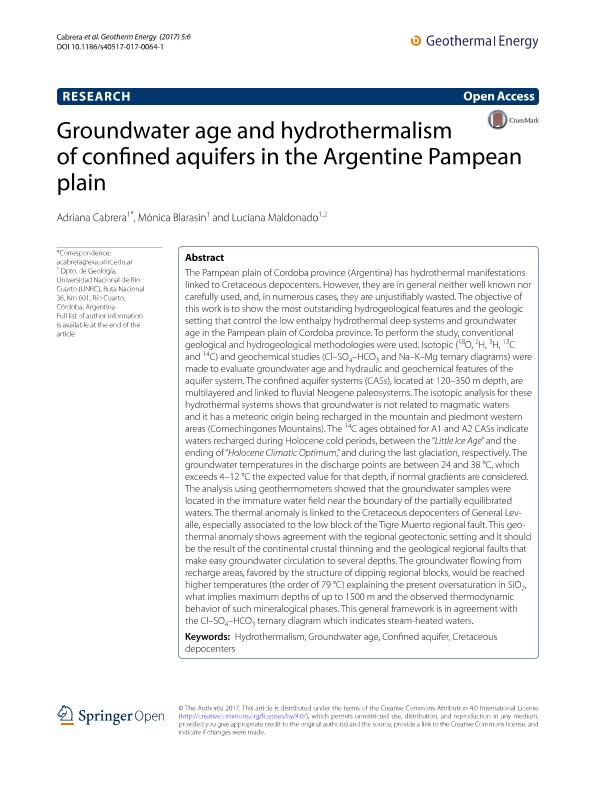Artículo
Groundwater age and hydrothermalism of confined aquifers in the Argentine Pampean plain
Fecha de publicación:
12/2017
Editorial:
SpringerOpen
Revista:
Geothermal Energy
e-ISSN:
2195-9706
Idioma:
Inglés
Tipo de recurso:
Artículo publicado
Clasificación temática:
Resumen
The Pampean plain of Cordoba province (Argentina) has hydrothermal manifestations linked to Cretaceous depocenters. However, they are in general neither well known nor carefully used, and, in numerous cases, they are unjustifiably wasted. The objective of this work is to show the most outstanding hydrogeological features and the geologic setting that control the low enthalpy hydrothermal deep systems and groundwater age in the Pampean plain of Cordoba province. To perform the study, conventional geological and hydrogeological methodologies were used. Isotopic ( 18 O, 2 H, 3 H, 13 C and 14 C) and geochemical studies (Cl–SO 4 –HCO 3 and Na–K–Mg ternary diagrams) were made to evaluate groundwater age and hydraulic and geochemical features of the aquifer system. The confined aquifer systems (CASs), located at 120–350 m depth, are multilayered and linked to fluvial Neogene paleosystems. The isotopic analysis for these hydrothermal systems shows that groundwater is not related to magmatic waters and it has a meteoric origin being recharged in the mountain and piedmont western areas (Comechingones Mountains). The 14 C ages obtained for A1 and A2 CASs indicate waters recharged during Holocene cold periods, between the “Little Ice Age” and the ending of “Holocene Climatic Optimum,” and during the last glaciation, respectively. The groundwater temperatures in the discharge points are between 24 and 38 °C, which exceeds 4–12 °C the expected value for that depth, if normal gradients are considered. The analysis using geothermometers showed that the groundwater samples were located in the immature water field near the boundary of the partially equilibrated waters. The thermal anomaly is linked to the Cretaceous depocenters of General Levalle, especially associated to the low block of the Tigre Muerto regional fault. This geothermal anomaly shows agreement with the regional geotectonic setting and it should be the result of the continental crustal thinning and the geological regional faults that make easy groundwater circulation to several depths. The groundwater flowing from recharge areas, favored by the structure of dipping regional blocks, would be reached higher temperatures (the order of 79 °C) explaining the present oversaturation in SiO 2 , what implies maximum depths of up to 1500 m and the observed thermodynamic behavior of such mineralogical phases. This general framework is in agreement with the Cl–SO 4 –HCO 3 ternary diagram which indicates steam-heated waters.
Palabras clave:
Confined Aquifer
,
Cretaceous Depocenters
,
Groundwater Age
,
Hydrothermalism
Archivos asociados
Licencia
Identificadores
Colecciones
Articulos(CCT - CORDOBA)
Articulos de CTRO.CIENTIFICO TECNOL.CONICET - CORDOBA
Articulos de CTRO.CIENTIFICO TECNOL.CONICET - CORDOBA
Citación
Cabrera, Adriana Edith; Blarasin, Mónica Teresa; Maldonado, Marina Luciana; Groundwater age and hydrothermalism of confined aquifers in the Argentine Pampean plain; SpringerOpen; Geothermal Energy; 5; 1; 12-2017
Compartir
Altmétricas




